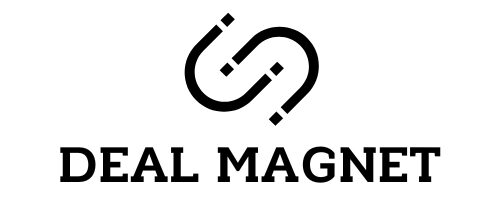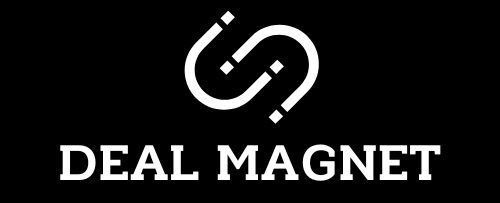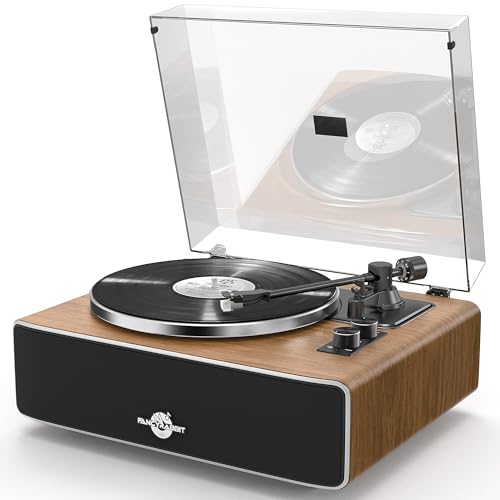“Dealmagnet.uk is a participant in the Amazon EU Associates Programme, an affiliate advertising programme designed to provide a means for sites to earn advertising fees by advertising and linking to Amazon.co.uk.”
In a world dominated by digital streaming, record players have made a stylish comeback, bridging the gap between vintage charm and modern sound quality. Vinyl records are no longer a thing of the past — they’re symbols of authenticity, nostalgia, and pure musical warmth. Whether you’re rediscovering old favorites or starting your vinyl journey, buying the right record player is crucial to your listening experience.
This buying guide will help you choose the perfect player — from understanding key features and setup requirements to exploring pros and cons and expert insights.
🧭 What to Consider Before Buying a Record Player
Before diving into the world of vinyl, it’s essential to understand the factors that define a great record player. Below are the key things to keep in mind:
🎚️ 1. Turntable Type
There are two main types:
- Belt-Drive Turntables:
- The platter spins via an elastic belt connected to the motor.
- Produces less motor noise and offers smoother sound.
- Best for audiophiles and casual listeners.
- Direct-Drive Turntables:
- The motor is directly connected to the platter.
- Offers faster start-up and better torque.
- Ideal for DJs and people who mix or scratch records.
👉 Tip: For home use and pure listening, belt-drive is often preferred. For professional use, direct-drive models are more reliable.
🎚️ 2. Manual vs. Automatic Operation
- Manual Turntables: Require you to place and lift the tonearm. Offers a more “hands-on” experience.
- Automatic Turntables: Start and stop with a button — perfect for beginners.
- Semi-Automatic: Stops automatically at the end of the record but requires manual start.
💡 Expert Insight: Manual models are favored by purists who enjoy the tactile feel of vinyl, while automatic ones provide convenience.
🔊 3. Built-in or External Speakers
- With Built-in Speakers: Convenient, portable, and beginner-friendly.
- Without Speakers (External Setup): Offer superior sound clarity and customization.
🎶 Pro Tip: If you plan to build a home audio setup, choose one with RCA outputs or Bluetooth connectivity for flexible pairing with external speakers.
🧩 4. Connectivity Options
Modern record players blend old-school audio with new-age tech. Look for:
- Bluetooth Output/Input: Stream vinyl wirelessly or play from your phone.
- USB Port: Convert vinyl tracks into digital format.
- RCA Outputs: Connect to amplifiers or powered speakers.
💽 5. Cartridge and Stylus Quality
The cartridge and stylus (needle) are responsible for reading the grooves on vinyl records.
- Moving Magnet (MM): Easy to replace and good for most listeners.
- Moving Coil (MC): Offers more detail and precision but is costlier.
🧠 Expert Note: For beginners, an MM cartridge is sufficient and delivers a warm, balanced tone.
🏗️ 6. Build Quality and Materials
A sturdy build reduces vibration and improves sound clarity.
- Look for aluminum platters, anti-skate controls, and damped tonearms.
- Heavy bases help reduce resonance and unwanted noise.
💡 7. Aesthetic and Design
Record players are not just audio devices — they’re statement pieces.
From retro wood finishes to sleek modern designs, choose one that complements your decor and personal style.
📊 Record Player Comparison Table
| Feature | Belt-Drive | Direct-Drive | Automatic | Manual |
|---|---|---|---|---|
| Noise Level | Low | Slightly higher | Very low | Depends on handling |
| Control | Simple | Fast start/stop | Easy | Fully manual |
| Durability | High | Very high | Medium | High |
| Ideal For | Home listening | DJs, studios | Beginners | Audiophiles |
⚖️ Pros and Cons of Record Players
✅ Pros
- Rich, warm analog sound unmatched by digital formats.
- Aesthetic appeal — blends retro vibes with modern interiors.
- Physical music experience — handling records creates emotional connection.
- Collectible hobby — vinyl records often appreciate in value.
- Modern versatility — many support Bluetooth and USB.
❌ Cons
- Requires proper maintenance (stylus cleaning, dusting).
- Space-consuming compared to streaming devices.
- High-quality components can be pricey.
- Delicate setup — improper calibration may affect sound quality.
🎯 Who It’s Best For
| User Type | Best Record Player Type | Why It Fits |
|---|---|---|
| Beginners | Automatic Belt-Drive with built-in speakers | Easy setup and use |
| Audiophiles | Manual Belt-Drive with external speakers | Superior sound fidelity |
| DJs | Direct-Drive Manual | Fast response and torque control |
| Vintage Enthusiasts | Retro design with Bluetooth | Combines classic and modern feel |
| Collectors | High-end Belt-Drive with USB | Best for archiving and recording vinyl digitally |
💬 Real Insights and Expert Opinions
- Sound Engineers’ View:
Audio professionals often prefer manual belt-drive turntables because of their smoother motion and minimal vibration interference. - Collector’s Experience:
Long-time vinyl collectors highlight the importance of stylus care and storage. Using anti-static sleeves and cleaning kits extends record life and improves sound quality. - Personal Note:
Many users report that switching from digital to vinyl offers a more immersive and soulful music experience. The tactile act of placing a record on the platter creates a sense of ritual that digital formats lack.
🧹 Maintenance Tips for Longevity
To keep your record player in top shape:
- Clean your stylus with a soft brush every few plays.
- Store records vertically in a dust-free environment.
- Use a record cleaning solution for deep cleaning grooves.
- Avoid direct sunlight and humidity near your setup.
- Replace the stylus after 500–1000 hours of playtime.
💡 Common Mistakes to Avoid
- Ignoring tracking force: Incorrect tonearm balance can damage records.
- Using poor-quality speakers: It limits the true potential of vinyl sound.
- Skipping maintenance: Dust buildup affects playback quality.
- Buying only for aesthetics: A beautiful turntable is great, but performance should come first.
❓ Frequently Asked Questions (FAQs)
1. Do I need an amplifier for a record player?
Not always. Many modern players have built-in preamps, allowing direct connection to powered speakers. If not, you’ll need an external preamp or receiver.
2. Can I connect a record player to Bluetooth speakers?
Yes! Many new models include Bluetooth output, letting you stream vinyl audio wirelessly.
3. How do I convert vinyl records to MP3?
Look for a USB-compatible record player. Connect it to your computer and use recording software to digitize your vinyl collection.
4. What’s the difference between 33, 45, and 78 RPM?
These numbers refer to record speeds:
- 33 RPM: Standard LPs (long play, ~20 mins per side).
- 45 RPM: Singles or extended plays.
- 78 RPM: Older shellac records (vintage).
5. How much should I spend on a good record player?
It depends on your use. Beginners can start with budget-friendly models ($100–$200 range), while serious audiophiles may prefer mid-to-high-end turntables ($300–$800+).
🏁 Final Recommendation
A record player is more than a sound device — it’s a gateway to musical nostalgia. Choosing the right one depends on your priorities: sound quality, design, convenience, or professional use.
If you’re new to vinyl, start simple: an automatic belt-drive player with built-in speakers. It’s easy to use and gives you a taste of analog sound. As your passion grows, upgrade to a manual turntable with external components to refine your listening experience.
No matter what you choose, remember — vinyl isn’t just about hearing music, it’s about feeling it.r belongings, and maintain a cleaner, healthier indoor environment all year round.
Latest Posts
- Smart Choices – The Ultimate Everyday Products Buying GuideALLWIN Disco Partylights – Music Control DJ Lights with Remote Control and USB, RGB Party Lights 60 Different Modes Karaoke Family Weddings Children’s Birthdays Kevsuvqin Card Shuffler Machine, 3000mAh Automatic Card Shuffler with USB Charging Cable, Two-deck Card Shuffling Machine, Low Noise Card Shufflers suitable for UNO, Poker, Texas Hold’em and blackjack USB Heated Gloves… Read more: Smart Choices – The Ultimate Everyday Products Buying Guide
- Clear Precision – The Ultimate Buying Guide for Glass ToolsZHJAN 2 Pack 8” Glass Suckers Lifters with Pressure Gauge,220kg Lift Capacity – Heavy Duty Vacuum Suction Cups with Carrying Case for Large Glass, Tile, Granite, Window Replacement “Dealmagnet.uk is a participant in the Amazon EU Associates Programme, an affiliate advertising programme designed to provide a means for sites to earn advertising fees by advertising… Read more: Clear Precision – The Ultimate Buying Guide for Glass Tools
- Spin in Style – The Ultimate Record Player Buying GuideHP-H2501 Retro Bluetooth Vinyl Record Player with Speakers, All-in-ONE Turntable with AT-3600L Cartridge, Belt Drive 2-Speed (33/45 RPM), Best for Music Lovers (HP-H2501) “Dealmagnet.uk is a participant in the Amazon EU Associates Programme, an affiliate advertising programme designed to provide a means for sites to earn advertising fees by advertising and linking to Amazon.co.uk.” In… Read more: Spin in Style – The Ultimate Record Player Buying Guide
- Breathe Easy: Your Complete Dehumidifier Buying GuideAROEVE Dehumidifier 1000ml, Dehumidifiers for Home, Auto Off, Auto Defrost, Peltier Technology, Coloured Light, Portable, Quiet, for Wardrobe, Bedroom, Bathroom “Dealmagnet.uk is a participant in the Amazon EU Associates Programme, an affiliate advertising programme designed to provide a means for sites to earn advertising fees by advertising and linking to Amazon.co.uk.” Humidity may be invisible,… Read more: Breathe Easy: Your Complete Dehumidifier Buying Guide
- Freedom to Clean: Your Ultimate Cordless Vacuum Buying GuideCordless Vacuum Cleaner,Stick Vacuum 45KPA/450W/60min,Wall-mounted Charging/V-shaped Anti-Tangle,with Self-standing Function and Removable Battery,Vacuum Cleaner for Pet Hair,Carpets and Hard Floors Ultenic T10 Lite Robot Vacuum Cleaner with Mop 5000Pa, 15min Lidar Quick Mapping, Self Charging & Emptying, Allergy Friendly, Carpet Auto-boost,Siri/Alexa/APP Remote Control Hoover for Floors Pet Hair Cordless Vacuum Cleaner 48KPa/550W/65min,Stick Vacuum Cleaner with Anti-Tangle… Read more: Freedom to Clean: Your Ultimate Cordless Vacuum Buying Guide
- Smart Choice: The Ultimate Smart Tablet Buying GuideDOOGEE 2025 Newest Android 15 Tablet, Tab E3 Pro 13 Inch Tablet, 32GB+256GB/2TB, Helio G100 Octa-Core Android Tablets, 11000mAh/18W, Large Tablets with SIM Card Slot, 3.5mm Jack/5G WiFi/8+13MP, Gray DOOGEE U11 Android 16 Tablets, Tablet 11 inch Android Tablets with 16GB RAM+128GB ROM+TF 2TB 8580mAh Battery, 90Hz IPS Screen, 13MP+5MP Camera,Wifi Gaming Tablet with Keyboard… Read more: Smart Choice: The Ultimate Smart Tablet Buying Guide
- Data on Demand: The Ultimate Hard Drive Buying Guide
 Aiolo Innovation 500GB Ultra Slim Portable External Hard Drive HDD-USB 3.0 for PC, Mac, Laptop, PS4, Xbox one,Xbox 363-Super Fast Transmission “Dealmagnet.uk is a participant in the Amazon EU Associates Programme, an affiliate advertising programme designed to provide a means for sites to earn advertising fees by advertising and linking to Amazon.co.uk.” In today’s digital… Read more: Data on Demand: The Ultimate Hard Drive Buying Guide
Aiolo Innovation 500GB Ultra Slim Portable External Hard Drive HDD-USB 3.0 for PC, Mac, Laptop, PS4, Xbox one,Xbox 363-Super Fast Transmission “Dealmagnet.uk is a participant in the Amazon EU Associates Programme, an affiliate advertising programme designed to provide a means for sites to earn advertising fees by advertising and linking to Amazon.co.uk.” In today’s digital… Read more: Data on Demand: The Ultimate Hard Drive Buying Guide - Power Up Smartly: Ultimate Charger & Battery Buying Guide
 Battery Charger Compatible with Dewalt 12V/20V Battery, 2-Ports Fast Charger Compatible with Dewalt DCB 203 204 205 206 201 120 127 Lithium Battery “Dealmagnet.uk is a participant in the Amazon EU Associates Programme, an affiliate advertising programme designed to provide a means for sites to earn advertising fees by advertising and linking to Amazon.co.uk.” From… Read more: Power Up Smartly: Ultimate Charger & Battery Buying Guide
Battery Charger Compatible with Dewalt 12V/20V Battery, 2-Ports Fast Charger Compatible with Dewalt DCB 203 204 205 206 201 120 127 Lithium Battery “Dealmagnet.uk is a participant in the Amazon EU Associates Programme, an affiliate advertising programme designed to provide a means for sites to earn advertising fees by advertising and linking to Amazon.co.uk.” From… Read more: Power Up Smartly: Ultimate Charger & Battery Buying Guide - Perfect Finish Every Time: Ultimate Paint Sprayer Buying Guide
 YIREAL Fence Paint Sprayer 800W,Electric Spray Paint Gun with 1300ml Container 3 Meters Cable 1.8M Hose,HVLP Spray Gun with 3 Nozzles 3 Spray Modes for Walls Ceilings Sheds Furniture House Painting “Dealmagnet.uk is a participant in the Amazon EU Associates Programme, an affiliate advertising programme designed to provide a means for sites to earn advertising… Read more: Perfect Finish Every Time: Ultimate Paint Sprayer Buying Guide
YIREAL Fence Paint Sprayer 800W,Electric Spray Paint Gun with 1300ml Container 3 Meters Cable 1.8M Hose,HVLP Spray Gun with 3 Nozzles 3 Spray Modes for Walls Ceilings Sheds Furniture House Painting “Dealmagnet.uk is a participant in the Amazon EU Associates Programme, an affiliate advertising programme designed to provide a means for sites to earn advertising… Read more: Perfect Finish Every Time: Ultimate Paint Sprayer Buying Guide - Sound Without Strings: Buying Guide for Wireless Earbuds & Earphones
 Niderson Wireless Earbuds, Headphones with Screen Stereo Bass, 48Hrs Playtime, Red Niderson Wireless Earbuds, Headphones with Screen Stereo Bass, 48Hrs Playtime, Grey Niderson Open Ear Wireless Earbuds Bluetooth Headphones, Grey Ear Buds for Fitness/Workouts/Travel “Dealmagnet.uk is a participant in the Amazon EU Associates Programme, an affiliate advertising programme designed to provide a means for sites… Read more: Sound Without Strings: Buying Guide for Wireless Earbuds & Earphones
Niderson Wireless Earbuds, Headphones with Screen Stereo Bass, 48Hrs Playtime, Red Niderson Wireless Earbuds, Headphones with Screen Stereo Bass, 48Hrs Playtime, Grey Niderson Open Ear Wireless Earbuds Bluetooth Headphones, Grey Ear Buds for Fitness/Workouts/Travel “Dealmagnet.uk is a participant in the Amazon EU Associates Programme, an affiliate advertising programme designed to provide a means for sites… Read more: Sound Without Strings: Buying Guide for Wireless Earbuds & Earphones - Smart Connections:Buying Guide for Adapters & Extensions
 AUNNO Double Shaver Plug Adaptor UK, 2500W 2 Way Plug Adapter for Bathroom Electric Razor and Electric Toothbrush etc, 2 Pin to 3 Pin Plug Adapter with 10A Fuse AUNNO Pack of 2 UK to European Plug Adapter, UK 3 Pin to European 2 Pin Plug Converter, Euro Type C, E, F and Type G,… Read more: Smart Connections:Buying Guide for Adapters & Extensions
AUNNO Double Shaver Plug Adaptor UK, 2500W 2 Way Plug Adapter for Bathroom Electric Razor and Electric Toothbrush etc, 2 Pin to 3 Pin Plug Adapter with 10A Fuse AUNNO Pack of 2 UK to European Plug Adapter, UK 3 Pin to European 2 Pin Plug Converter, Euro Type C, E, F and Type G,… Read more: Smart Connections:Buying Guide for Adapters & Extensions - Clean Smarter: The Ultimate Vacuum Cleaner Buying Guide
 Ultenic U15 Cordless Vacuum Cleaner 50000Pa/65Min Runtime, Anti-tangle Brush with GreenEye Technology, Self Standing Stick Vacuum, Telescopic Tube, Ideal for All Floors, Carpet & Pet Hair “Dealmagnet.uk is a participant in the Amazon EU Associates Programme, an affiliate advertising programme designed to provide a means for sites to earn advertising fees by advertising and linking… Read more: Clean Smarter: The Ultimate Vacuum Cleaner Buying Guide
Ultenic U15 Cordless Vacuum Cleaner 50000Pa/65Min Runtime, Anti-tangle Brush with GreenEye Technology, Self Standing Stick Vacuum, Telescopic Tube, Ideal for All Floors, Carpet & Pet Hair “Dealmagnet.uk is a participant in the Amazon EU Associates Programme, an affiliate advertising programme designed to provide a means for sites to earn advertising fees by advertising and linking… Read more: Clean Smarter: The Ultimate Vacuum Cleaner Buying Guide - Smart Picks: The Ultimate Smartphone Buying Guide
 DOOGEE Note 56 Mobile Phones, Newest Android 16 Smartphone, 6150mAh, 8.45mm Ultra-Slim, 6.56″ HD+ 90Hz, 24GB + 64GB/2TB Android Phones, Dual SIM Unlocked Mobile Phone, Face ID, GPS, OTG, FM-White DOOGEE Fier 5 Pro Android 15 Rugged Smartphone & Gemini AI – 20GB + 128GB, 13000mAh & MTK Helio G81 Octa Core Rugged Phone,90Hz 6.6″… Read more: Smart Picks: The Ultimate Smartphone Buying Guide
DOOGEE Note 56 Mobile Phones, Newest Android 16 Smartphone, 6150mAh, 8.45mm Ultra-Slim, 6.56″ HD+ 90Hz, 24GB + 64GB/2TB Android Phones, Dual SIM Unlocked Mobile Phone, Face ID, GPS, OTG, FM-White DOOGEE Fier 5 Pro Android 15 Rugged Smartphone & Gemini AI – 20GB + 128GB, 13000mAh & MTK Helio G81 Octa Core Rugged Phone,90Hz 6.6″… Read more: Smart Picks: The Ultimate Smartphone Buying Guide - Brew It Right: Your Coffee Buying Guide
 KOFIKOFI 54mm Bottomless Portafilter, Walnut Handle 3 Ears Naked Portafilter with Puck Screen, Compatible with Sage Breville Barista Series 500-880, Barista Express, and More 54mm Models KOFIKOFI Portafilter 58mm 2 Ears, Compatible with Gaggia Classic Espresso Machines, Naked Bottomless Portafilter with Puck Screen and Filter Basket (Black) KOFIKOFI Bottomless Portafilter 58mm with Puck Screen and… Read more: Brew It Right: Your Coffee Buying Guide
KOFIKOFI 54mm Bottomless Portafilter, Walnut Handle 3 Ears Naked Portafilter with Puck Screen, Compatible with Sage Breville Barista Series 500-880, Barista Express, and More 54mm Models KOFIKOFI Portafilter 58mm 2 Ears, Compatible with Gaggia Classic Espresso Machines, Naked Bottomless Portafilter with Puck Screen and Filter Basket (Black) KOFIKOFI Bottomless Portafilter 58mm with Puck Screen and… Read more: Brew It Right: Your Coffee Buying Guide - Clean Smarter, Not Harder: The Ultimate Vacuum Cleaner Buying Guide
 Ultenic U20 Cordless Vacuum Cleaner 55KPa/60Min,Enhanced Powerful Suction, Upgraded Anti Hair Wrap Brush with Fordable Wand, LED Countdown Display, Self Standing Hoover for Floors, Carpet & Pet Hair “Dealmagnet.uk is a participant in the Amazon EU Associates Programme, an affiliate advertising programme designed to provide a means for sites to earn advertising fees by advertising… Read more: Clean Smarter, Not Harder: The Ultimate Vacuum Cleaner Buying Guide
Ultenic U20 Cordless Vacuum Cleaner 55KPa/60Min,Enhanced Powerful Suction, Upgraded Anti Hair Wrap Brush with Fordable Wand, LED Countdown Display, Self Standing Hoover for Floors, Carpet & Pet Hair “Dealmagnet.uk is a participant in the Amazon EU Associates Programme, an affiliate advertising programme designed to provide a means for sites to earn advertising fees by advertising… Read more: Clean Smarter, Not Harder: The Ultimate Vacuum Cleaner Buying Guide



